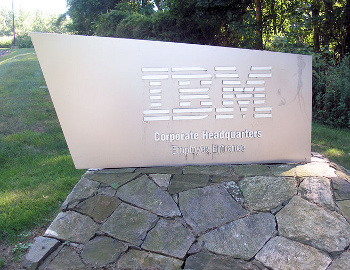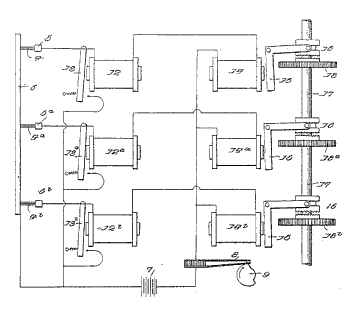100 Years of IBM
June 20, 2011
Corporations have reasonable longevity, but it's rare for a company to exist longer than about fifty years. The usual life expectancy of a
Fortune 500 company is about 40-50 years. As an example, one-third of companies on the Fortune 500 list in 1970 we gone by 1983. They disappeared either through
merger, acquisition or dissolution.[1-2]
IBM was a near casualty to the changing computing business environment when its stock sank to a low of $10.50 in July, 1993. IBM's stock now sits at about $160 as it celebrates its 100th anniversary.[3-8]

Entrance to IBM Corporate Headquarters
(Via Wikimedia Commons)
Before I recite some of IBM's milestones of those hundred years, things you likely will have read in many other articles last week, I'll lead off with one of my favorite IBM jokes; a possibly
apocryphal anecdote that an IBM employee told me in the 1970s; and how
distance learning worked in the 1970s.
In the late 1960s, IBM had the tactic of pre-announcing its new
mainframe products to keep its customers from jumping ship to other vendors with more powerful machines. The problem was that the new machines couldn't be shipped for quite a while after the pre-announcement. There's a story about a girl who married an IBM salesman. When one of her friends asked her how she enjoyed married life, she explained that every night her husband would sit on the bed, tell her how great their lovemaking was going to be, but would never deliver.
Now for the (possibly apocryphal) anecdote. A young
engineer joined IBM, and in those days before
cube farms, every engineer got an office. His office was small, but comfortable, with a wall-to-wall carpet. After a week, a maintenance man entered the office and started to cut away six inches of carpet from every wall. The astonished engineer asked why, and it was explained that employees at his
level didn't get wall-to-wall carpets.
When I was a graduate student, one of my professors taught a course at an IBM facility. The interesting thing was that he was in
Syracuse, New York, and the IBM facility was in
Poughkeepsie, New York, a little more than 200 miles away. One day each week, he and a corp of about five other professors would board a small private plane in Syracuse, and they would be flown to Poughkeepsie and back. I accompanied my professor on one of these trips to teach a session in
alloy chemistry, and it was an interesting experience. Distance learning is somewhat easier with the Internet.
There's been a lot written about IBM over the years, primarily because IBM is a big target. It employs 427,000 people worldwide and has revenues of about $100 billion.[8] When it was founded as the Computing-Tabulating-Recording Company on June 16, 1911, in a merger of four smaller companies, it had an annual revenue of about a million dollars.[6] The company changed its name to International Business Machines in 1924 when it went international by buying the
German company, Deutsche Hollerith Maschinen Groupe.[4] Its early principal products were quite prosaic, and included
time clocks and
weighing scales.
IBM's call to glory happened in 1935 with the passage of the
Social Security Act. With that law, the US government started its long history of mega-bookkeeping operations in issuance of
social security numbers to 26 million people. The law affected not just the government, but the many employers who needed to establish workable payroll systems. IBM, with its
punched card sorters and systems, was the company best able to meet the demand for payroll equipment. I wrote about punched cards in a
previous article (Punch Cards, September 13, 2010).

Fig. 2 of US Patent No. 1,109,842 (September 8, 1914), issued to Herman Hollerith for an "Apparatus for Use in Tabulating Systems."[9]
Simple mechanical devices like this were the start of IBM's computing hegemony)
IBM developed much early computer hardware, such as the
magnetic disc drive (the
RAMAC Disk Storage Unit),
ferrite core memory and
dynamic random access memory (DRAM). My first real computing experience was on an
IBM System/360. The 360 and its successors were a major force in mainframe computing in the 1960s and 1970s. With the
personal computer revolution, IBM was forced to reinvent itself, and it functions now as a
software and
services company. IBM is the eighteenth-largest U.S. corporation.
IBM has been innovative in more than just computing technology. Many years before the
Civil Rights Act of 1964, it had an equal opportunity policy. It hired its first black salesman in 1946; and, prior to that, had its first woman vice president in 1943.[4] The other side of the coin is IBM's reduced US workforce, and its continued
outsourcing to other countries.
Time magazine writes that the IBM workforce of about 120,000 in
India is greater than its US workforce.[5] The local newspaper in Poughkeepsie, the community that I visited on my IBM distance teaching experience in the 1970, quotes a
union watchdog that claims that IBM has shed 15,000 US employees in just the past few years.[7] That's quite a change from the 1960s, when IBM invested $5 billion in
research and development in the US on its System/360.[8]
IBM's embrace of Linux is an important factor in today's computing. Application software developers realize that computing hardware and operating system software are just utilities. This idea that the application is king is quite different than the philosophy of
Apple, which wants to act as gatekeeper for applications running in its environments.
What article about IBM would be complete without a closing chorus of the IBM
fight song (1931, Ever Onward -- Ever Onward!)[6]
That's the spirit that has brought us fame!
We're big, but bigger we will be
We can't fail for all can see
That to serve humanity has been our aim!
Our products now are known, in every zone,
Our reputation sparkles like a gem!
We've fought our way through -- and new
Fields we're sure to conquer too
For the EVER ONWARD I.B.M.
References:
- Arie de Geus and Peter M. Senge, "The Living Company," Harvard Business School Press, January, 1997, 215 pages (via Amazon).
- THE LIVING COMPANY: Habits for survival in a turbulent business environment, Business Week.
- Jim Zarroli, "IBM Turns 100: The Company That Reinvented Itself," NPR Morning Edition, June 16, 2011.
- IBM celebrates 100th anniversary, Telegraph (UK), June 16, 2011.
- Zachary Karabell, "Big Blue Turns 100: IBM’s Anniversary is One to Celebrate," Time, June 16, 2011.
- Alexis Madrigal, "IBM's First 100 Years: A Heavily Illustrated Timeline," The Atlantic, June 16, 2011.
- Craig Wolf, "IBM watchdog: Festivities 'ring hollow'," Poughkeepsie Journal, June 15, 2011.
- Rich Karlgaard, "IBM Turns 100 — An Interview with CEO Sam Palmisano," Forbes Blog, June 15, 2011.
- Herman Hollerith, "Apparatus for Use in Tabulating Systems," US Patent No. 1,109.861, September 8, 1914.
Permanent Link to this article
Linked Keywords: Corporation; Fortune 500; merger; acquisition; IBM; Wikimedia Commons; apocryphal; anecdote; distance learning; mainframe; engineer; cube farm; General Schedule; Syracuse, New York; Poughkeepsie, New York; alloy; chemistry; German; time clock; weighing scale; Social Security Act; social security number; punched card; US Patent No. 1,109,842; magnetic disc drive; RAMAC Disk Storage Unit; ferrite core memory; dynamic random access memory (DRAM); IBM System/360; personal computer; software; services; Civil Rights Act of 1964; outsourcing; Time magazine; India; union; watchdog; research and development; Linux; Apple; fight song; Arie de Geus; Peter M. Senge; The Living Company.